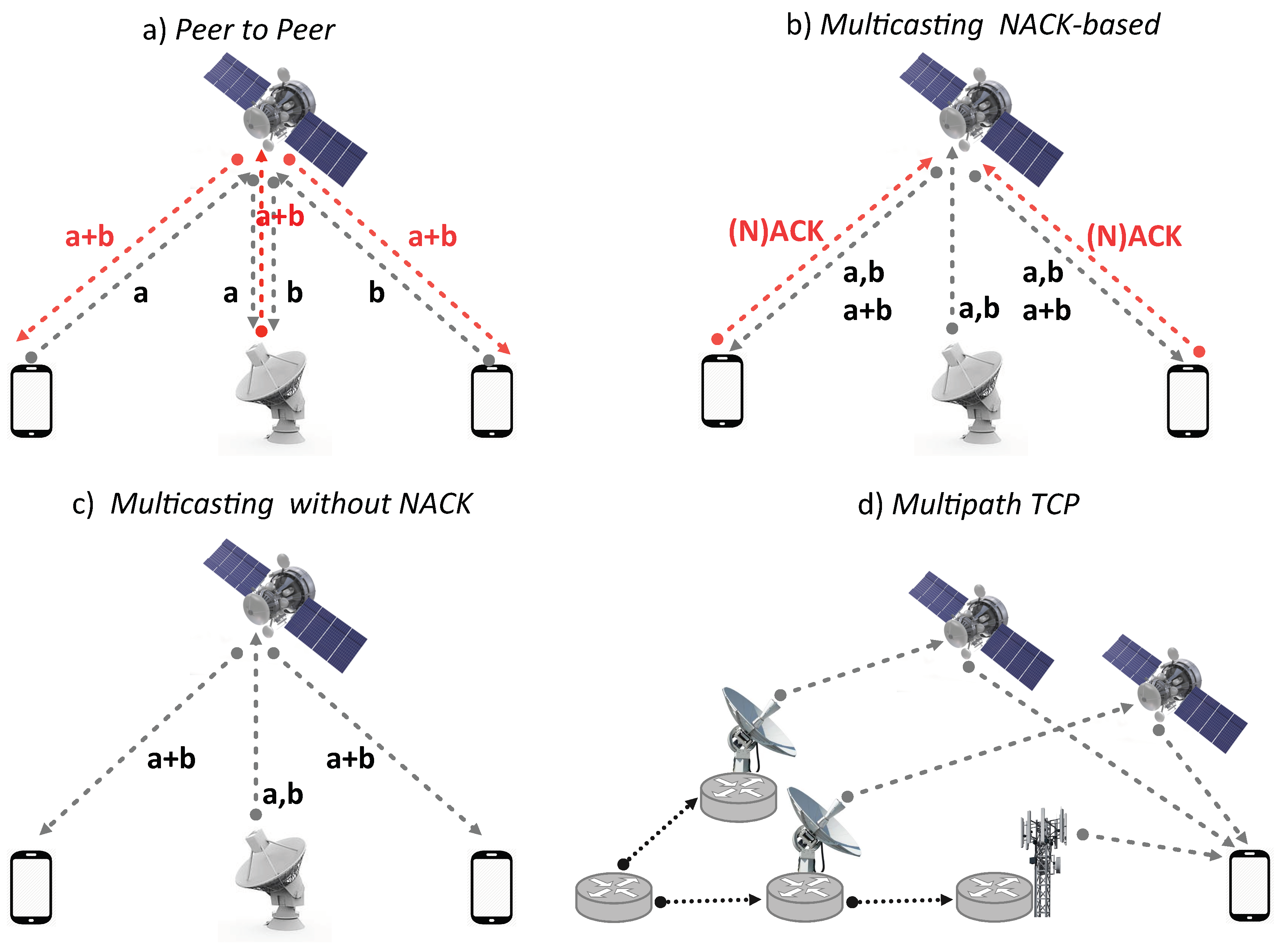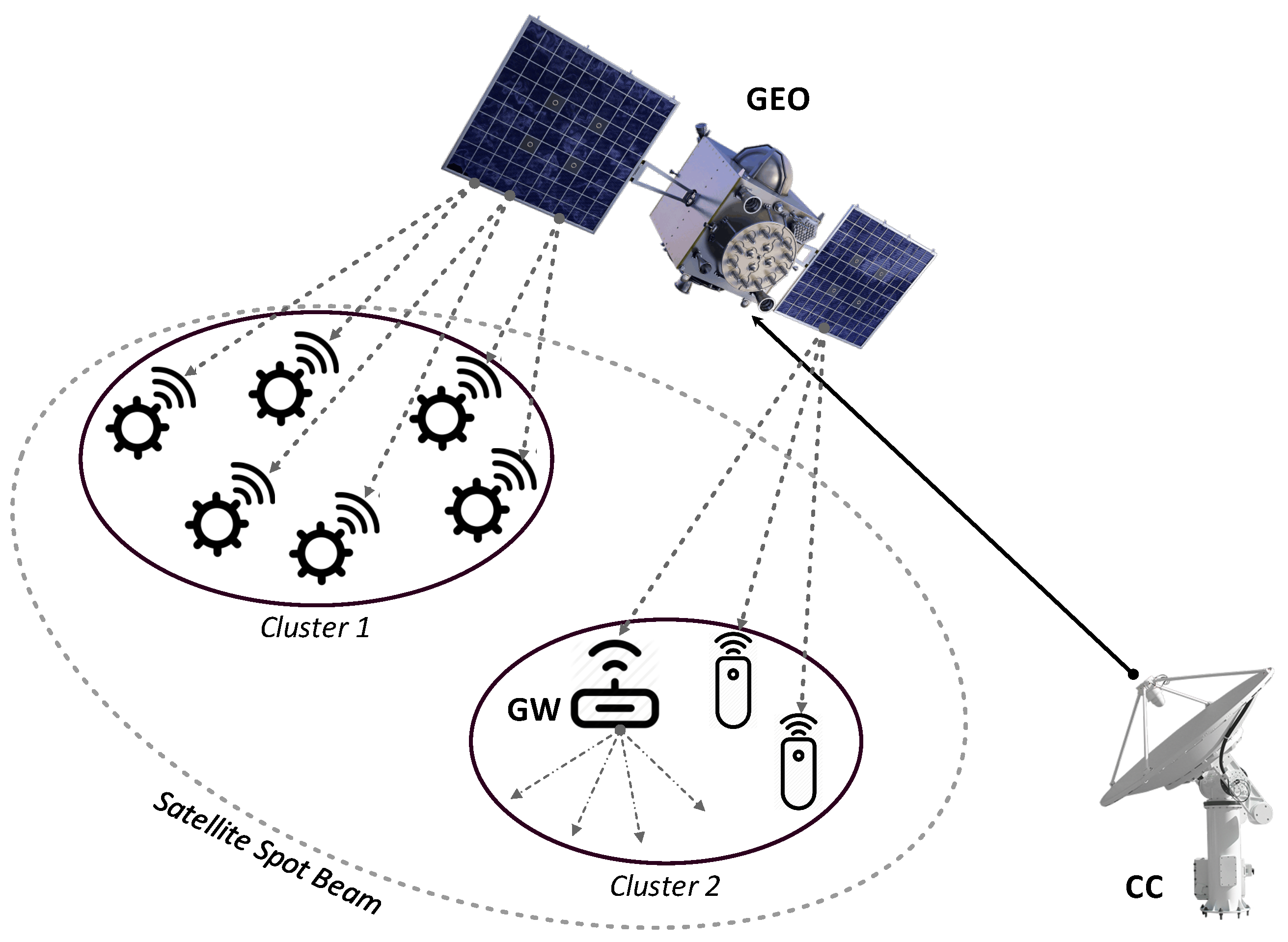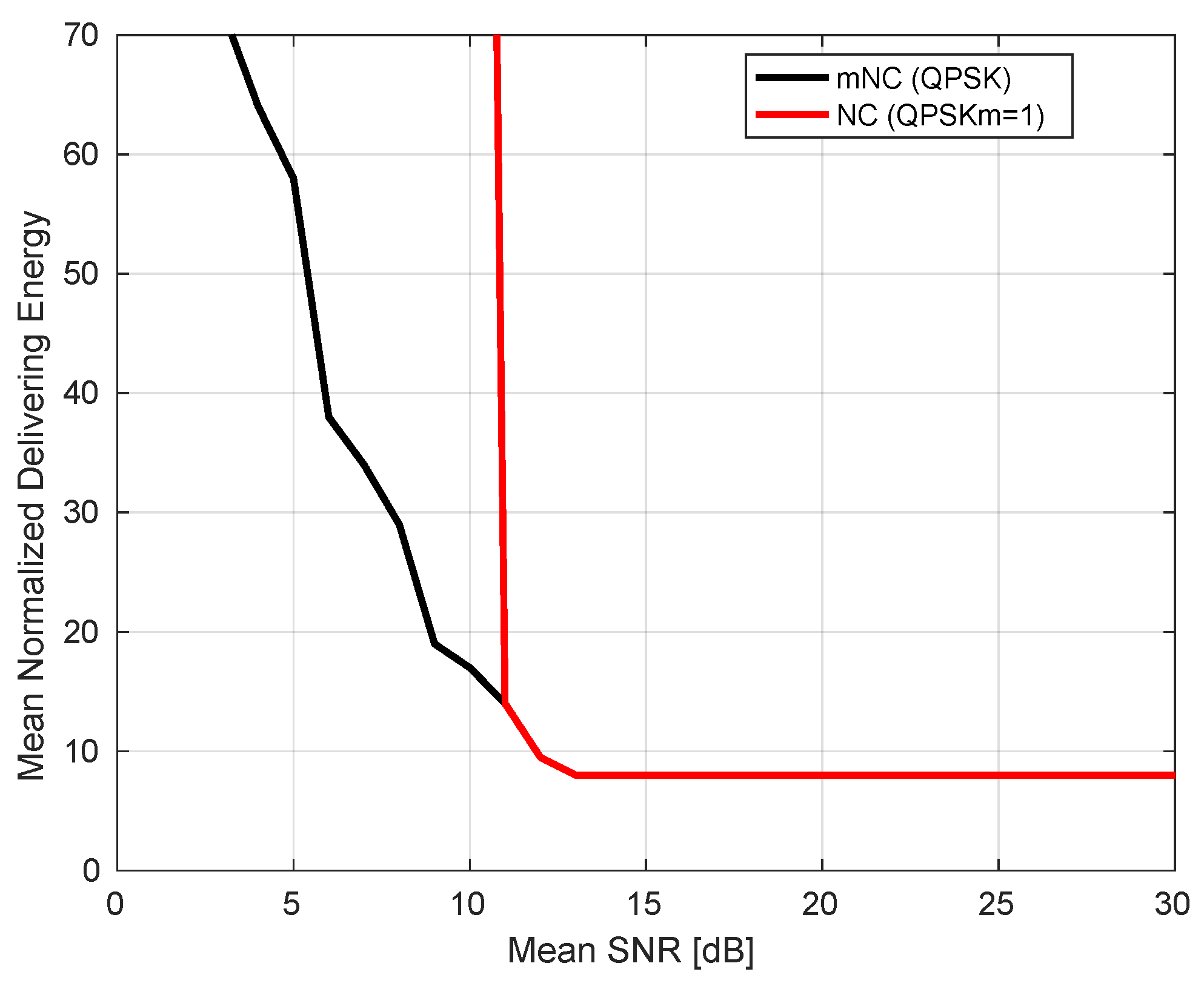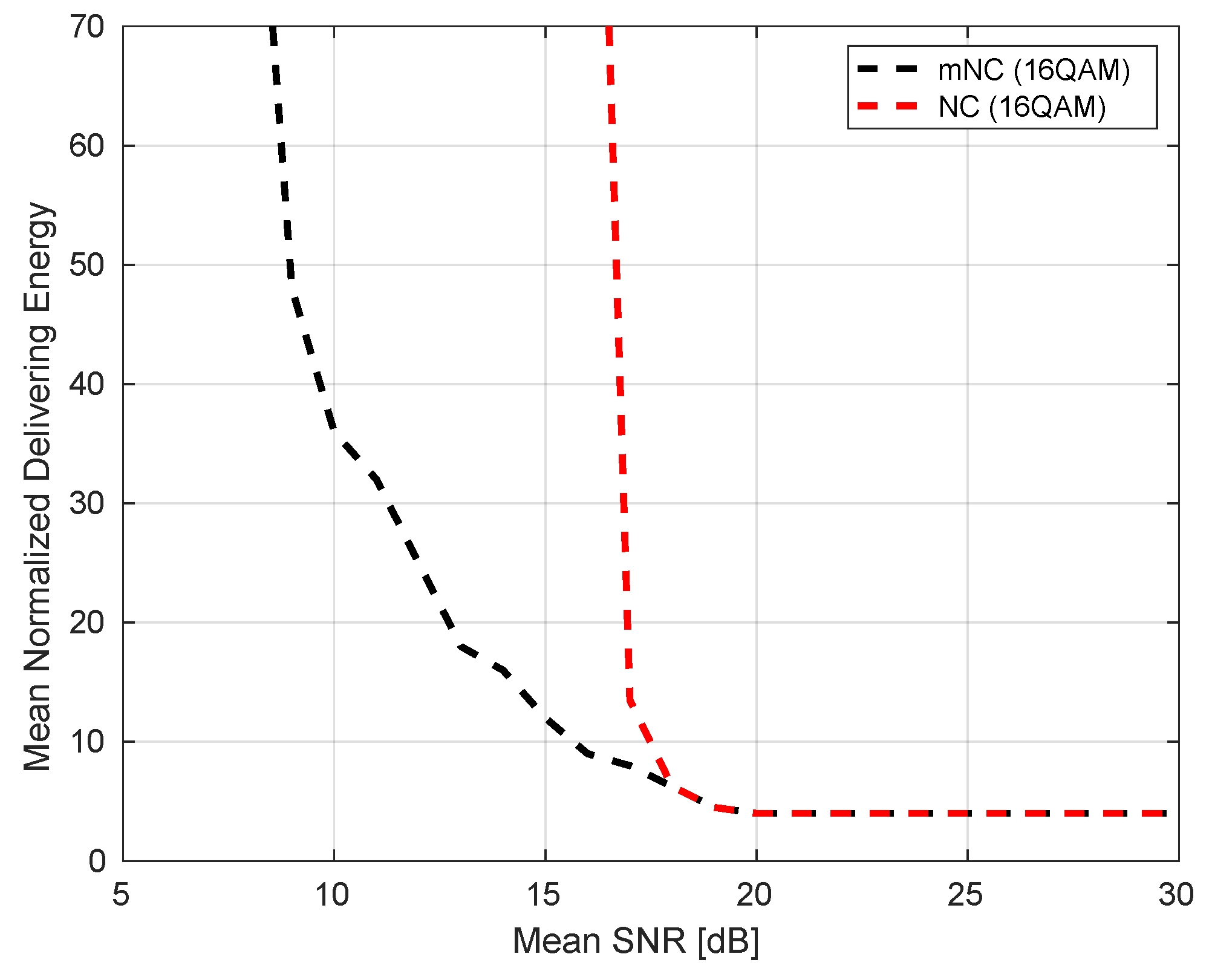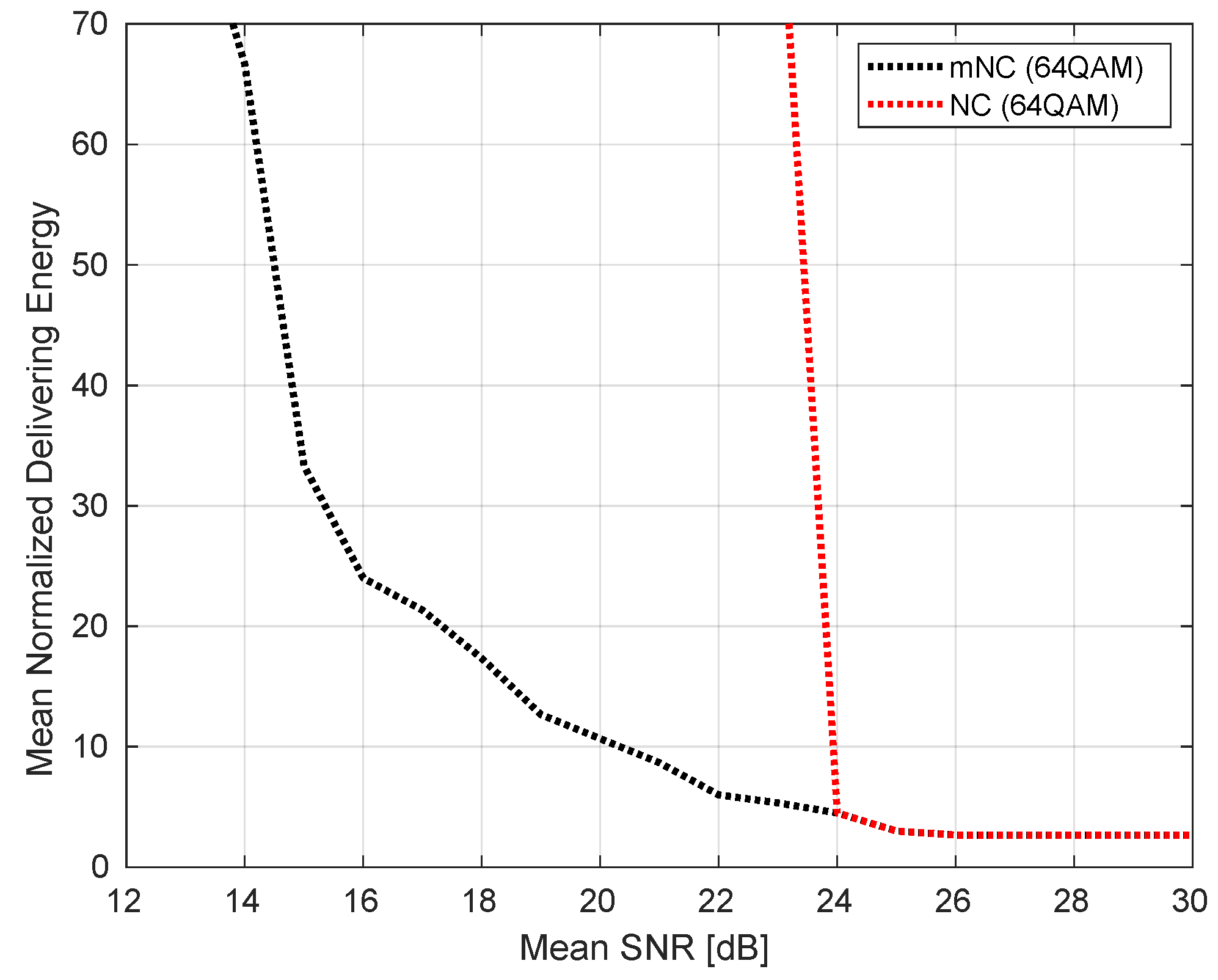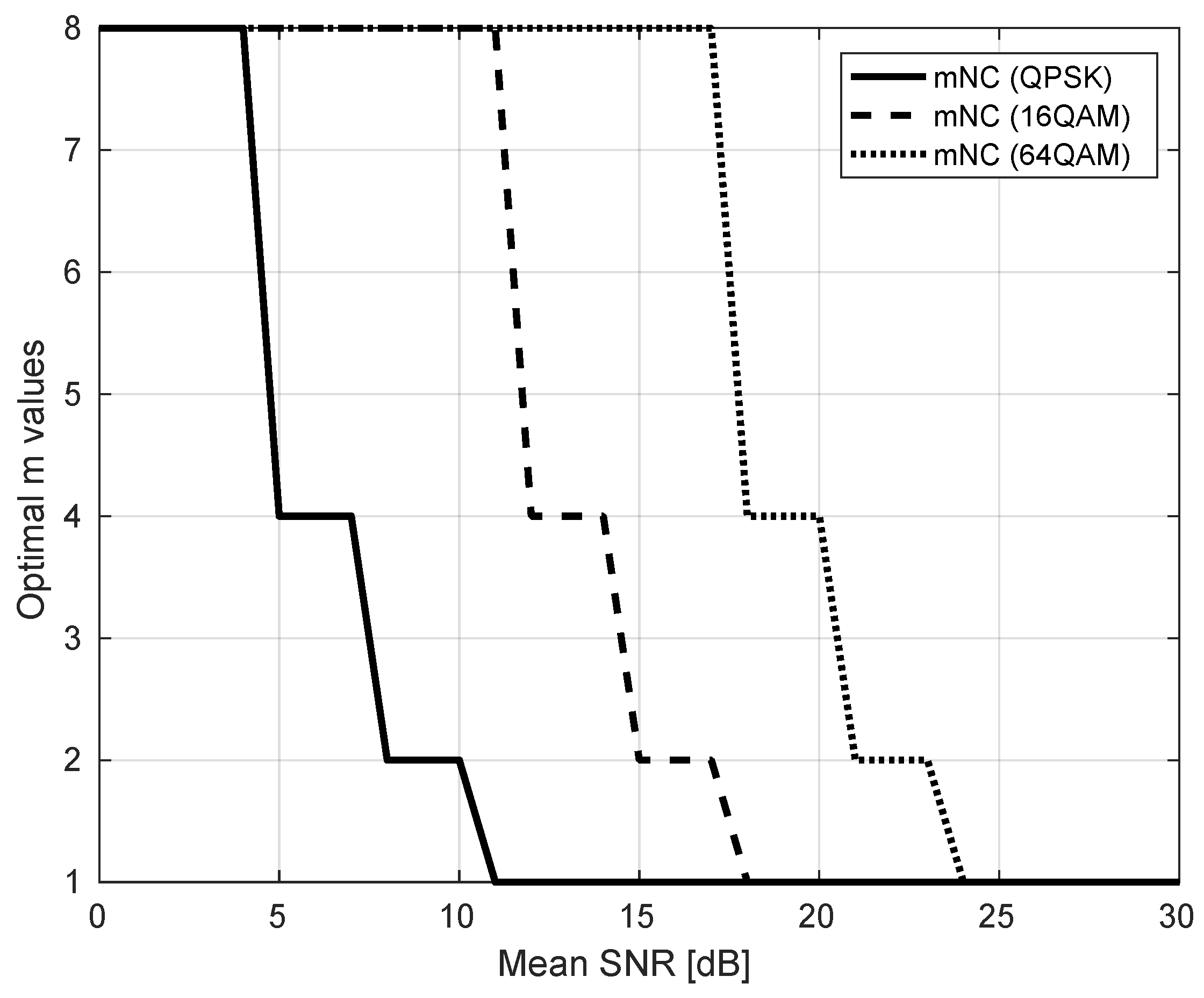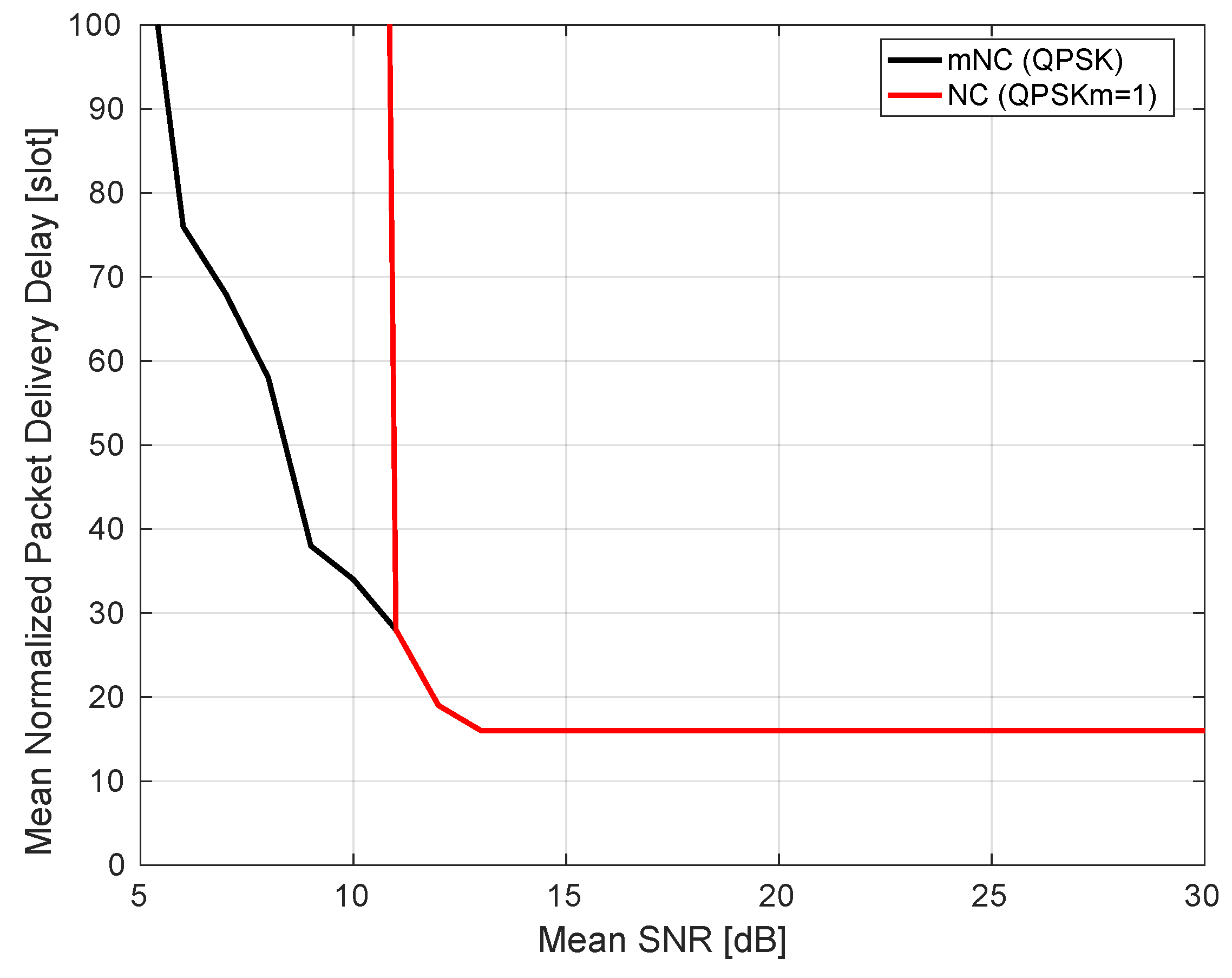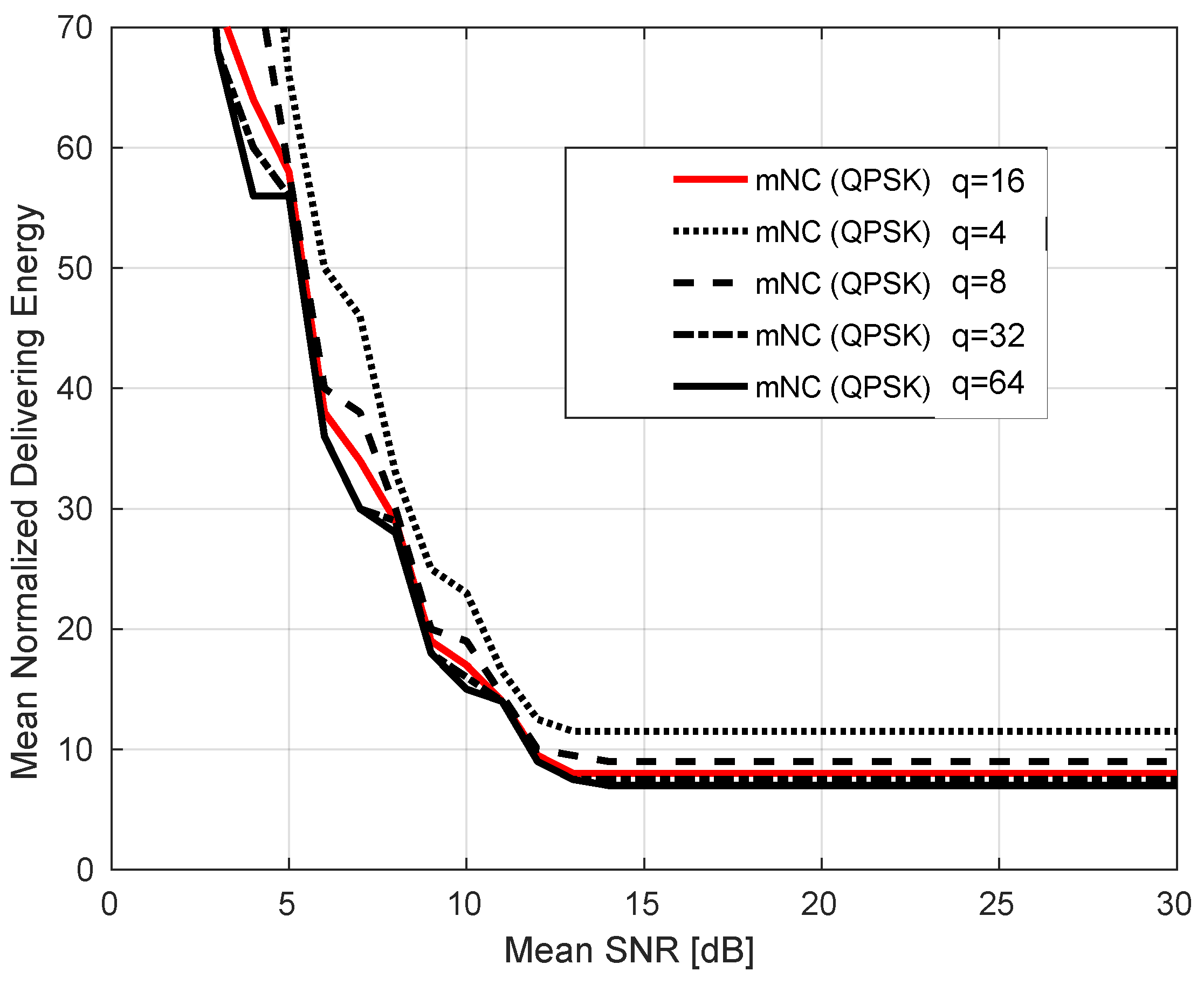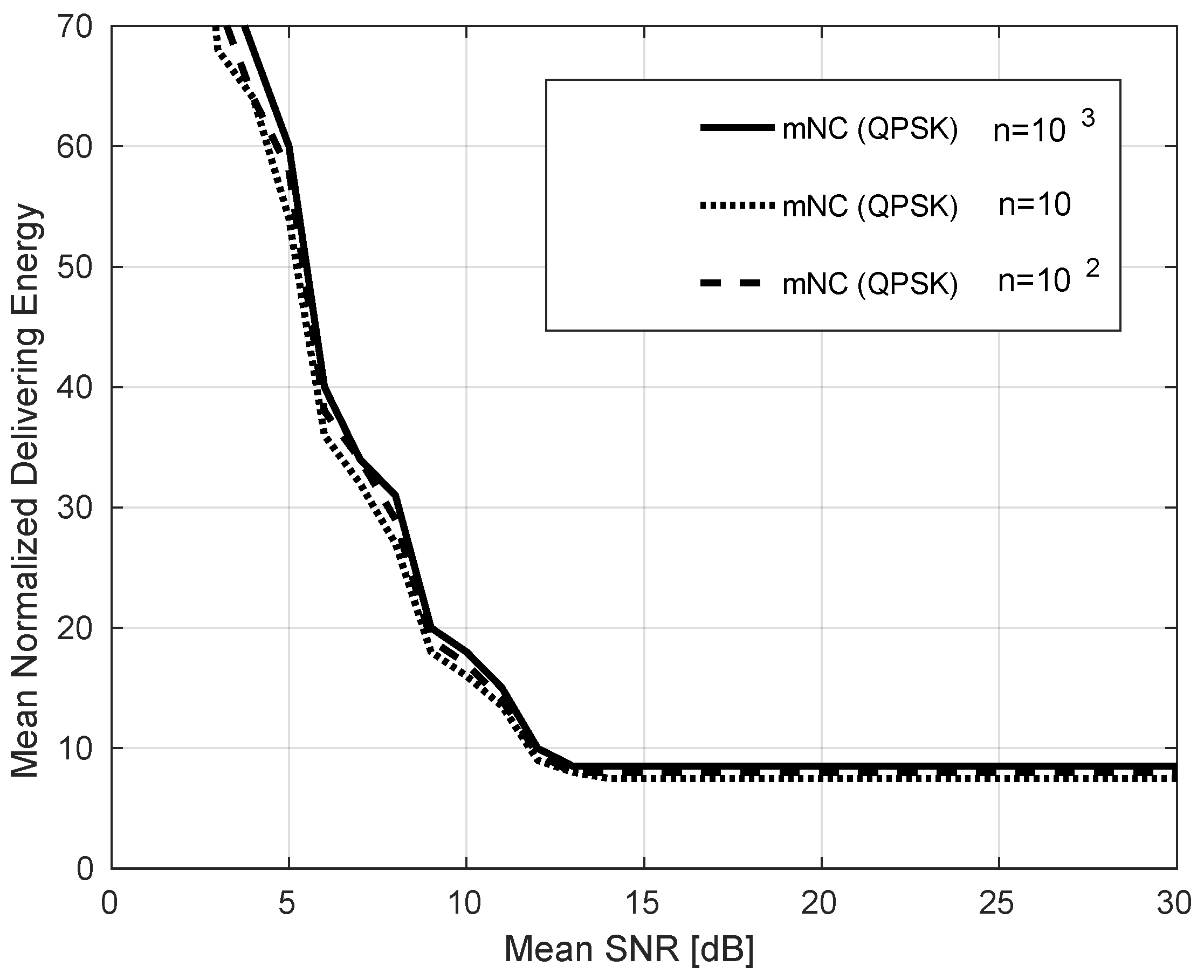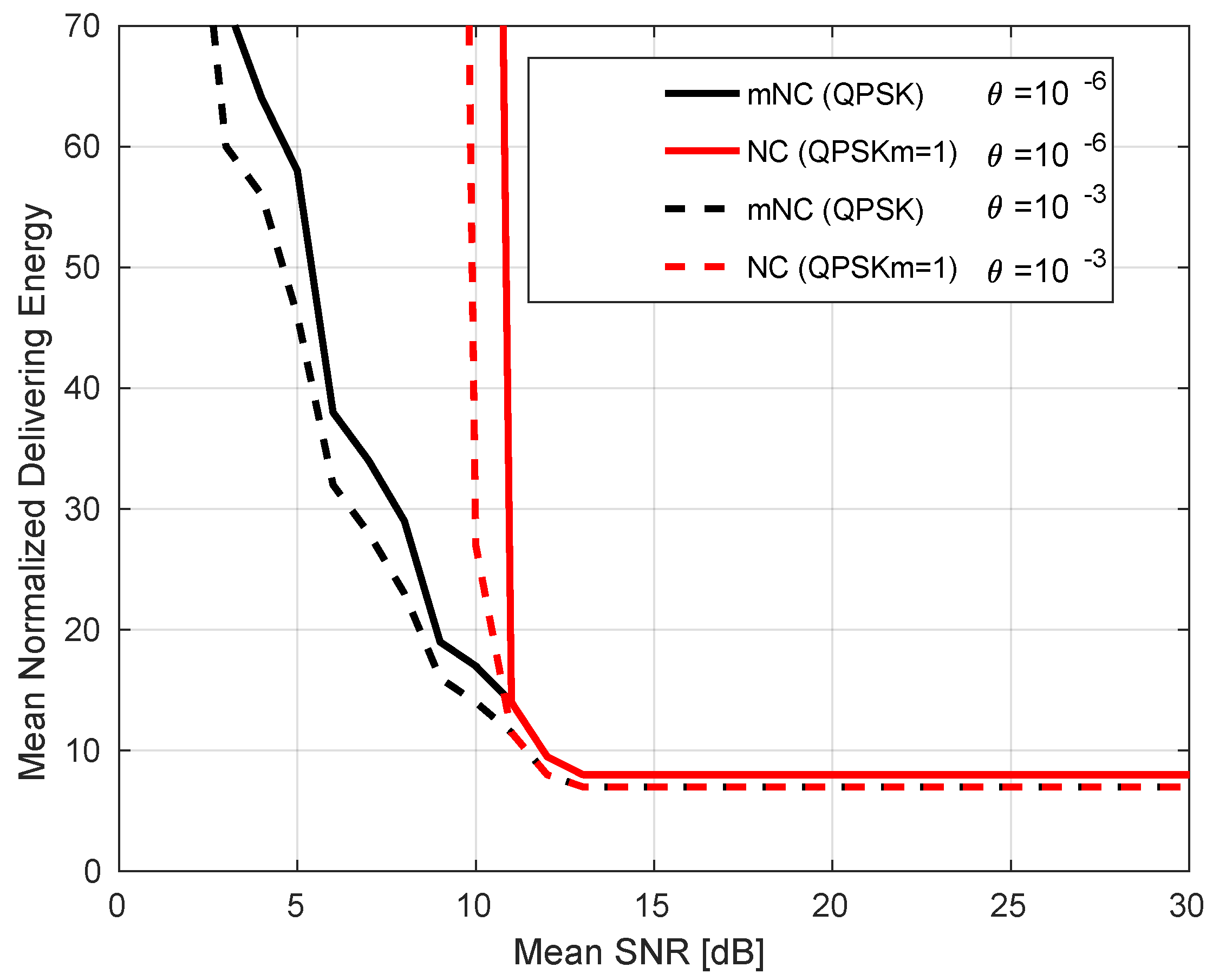1. Introduction
The new fifth generation (5G) cellular system has been recently defined as the network of networks because it should consist of multiple seamlessly-integrated radio access technologies (RATs). In addition, the 5G system has been addressed as a densification of networks for its ability to dynamically integrate heterogeneous networks, from Wi-Fi access points, machine-to-machine (M2M) communications, and Device to Device (D2D) communications up to small cells also operating in the millimeter wave bands [
1,
2]. Finally, 5G could be considered a dense network for its challenge to connect a massive number of things, i.e., the billions of objects and devices expected in 2022 to be on the Internet of Things (IoT) [
3,
4,
5].
Recently, terrestrial low-power, wide area network (LPWAN) technologies have been proposed to interconnect massive IoT devices on licensed/unlicensed frequencies, including proprietary and open standard options, for instance the proprietary, unlicensed: (1) SigFox ultra-narrowband technology, operating over a public network in the 868 MHz or 902 MHz bands; (2) LoRa spread-spectrum technology transmitting in several sub-gigahertz frequencies of Industrial, Scientific and Medical (ISM) band; and (3) the open standards of the 3rd Generation Partnership Project (3GPP), i.e., (i) the Narrowband-IoT (NB-IoT); and (ii) LTE-M operating on existing licensed bands of the Global System for Mobile communications (GSM) and Long Term Evolution (LTE), respectively.
In this context, satellite technology plays a key role to provide anywhere global IoT connectivity, especially for mission critical and industrial applications. LPWAN terrestrial solutions can support massive IoT devices, while a satellite link, usually via a concentrator (gateway) can provide connectivity among LPWAN networks in remote areas such as desolate tundra or oil platforms on the sea. For these scenarios, the latency requirements are often relaxed for many IoT applications, e.g., for continuous monitoring of air pollution or wildlife positions, and the low data rate transmission allows the use of low bandwidth satellite infrastructure [
6].
The IoT platform provider Stream Technologies and the LoRa Alliance already support reliable delivering of near real-time communications for a global connectivity over Iridium mesh architecture, which comprises 66 Low Earth Orbit (LEO) satellites. In addition, Vodafone and Inmarsat provide satellite backhaul for IoT devices to remotely track animals in wide geographical rural areas. Additionally, the support of direct access of IoT devices to satellite is the challenge taken by ORBCOMM even if the requirements of low maintenance costs and extremely long battery duration are quite demanding. In any case, the satellite segment must be part of the mix of 5G access technologies, as considered in 3GPP Release 16, for its major advantage to cover global areas and for providing the increasing dominant IoT connectivity guaranteed by the advent of 5G era.
Another key point of satellite technology is the ability to
multicast a message to a group of IoT devices over a large area, hence driving down cost. This is particularly relevant in several M2M/IoT applications, where smart devices could be grouped according to their services requirements and/or for the information that they need to receive. In this context, reliable satellite multicast communications can reduce the control signals overhead and the overall energy consumption. For example, the forward link communication could be used to provide alerts or commands to a group of actuators deployed in a large and inaccessible area or in emergency situations to support communications among rescuers for updating periodically their position in disaster area and/or for sending some updates including warning, alarms and security messages [
7]. Besides, satellites can simultaneously deliver software/firmware update towards a large number of cars or multicast traffic and road conditions information, together with indicating of alternative routes by guaranteeing the continuity of communications, without the risk of losing the connection, as can happen in terrestrial wireless network due to sudden traffic peaks. Moreover, the satellite high speed backhaul connectivity allows multicasting the same content (video or HD/UHD TV) since content distribution remains mainly a key satellite-based service. In particular, for these bandwidth-hungry services, the satellite can be used for off-loading the terrestrial 5G networks traffic.
In this paper, we apply an advanced Network Coding (NC) scheme to reliable multicast, typically for content delivery or reconfiguration to a M2M/IoT group-based devices, and we propose an approach to optimize the overall end-to-end energy consumption for a hybrid IoT 5G/satellite scenario. The adopted NC method assures an efficiency improvement because the acknowledgments, usually needed from each terminal, can be avoided, thus minimizing both the delivery delay and the energy consumption to decode the data flow. In addition, to minimize the required energy for the overall multicast packet transmission, an optimized transmission scheme is introduced, where multiple data symbols are replicated over multiple subcarriers of orthogonal frequency division multiplexing (OFDM) signal, by varying: (i) the adopted modulation schemes according to the channel conditions; and (ii) the number of coded packets K needed to be transmitted to all the on-Earth devices with the constrained of a target outage probability for the group-based sensors/devices.
In [
8], a similar reference scenario for reliable multicast content delivery applications and NC technique is also introduced. However, in this paper, a completely different methodology is proposed as follows: (i) NC operations are carried out at the ground control center (CC) as more transparent Geostationary Earth Orbit (GEO) satellite is considered while in [
8] a satellite with on-board processing capabilities for NC is assumed; (ii) data symbols are replicated in the frequency domain, while in [
8] a rate reduction factor is used to increase the time duration of data symbols; and (iii) we stress that our goal is different from the in [
8] because here the repetition factor is used to enforce the transmission for minimizing the overall delivering energy of the hybrid satellite/terrestrial system.
The evaluation and performance assessment of the proposed scheme are addressed by providing numerical results. Finally, the conclusions are outlined.
2. Iot over 5G/Satellite
The massive number of connected sensors/actuators and vehicles in IoT scenarios, often distributed in wide and remote areas, usually require satellite technology. The hardware and energy constrained IoT communications in unlicensed bands below 1 GHz (or on ISM band) and satellite communications at frequencies above 10 GHz favor a hybrid terrestrial/satellite solution, where terrestrial LPWAN networks act together with 5G systems, which could cover the same technology and waveforms of satellite, e.g., in part of C-band, to provide a global connectivity [
9,
10].
Satellite could complement terrestrial networks and the challenges of facing: (1) direct connection of billions of IoT devices in a resource efficient way with the new narrow band satellite communication technologies; (2) the interoperability between satellite systems and a plethora of different RAT technologies and the heterogeneity of sensors/devices; and (3) efficient multicast delivery of the same content stored in 5G small cells data caches to support applications that require very low (sub-1ms) latency.
The unprecedented opportunity for the satellite to provide a significant contribution is linked to the definition and implementation of the network slices, which represent one of the pillars introduced in 5G and represent the set of infrastructures and protocols made available to satisfy the requirements of a service, also drawing on different technological domains (multi-tenant) [
11]. In addition, to enhance the satellite network device interoperability, and the integration of satellite and terrestrial networks, Software-Defined Networking (SDN) has recently been introduced into this domain due to its expected flexibility, programmability, simplified management, and reduced operating costs [
12].
Satellite systems are historically efficient point-to-multipoint distribution platforms. An interesting overview of the use of satellite in remote IoT environment can be found in [
7]. This work highlights the main applications of IoT via satellite such as smart grid, environmental monitoring and emergency management by identifying challenges and issues for an efficient satellite support to M2M/IoT networks. Specifically, they have been pointed out as: (1) specific MAC protocols to assure the access of sensors to the satellite resources; and (2) the support of IPv6 over satellite.
IoT applications usually rely on a group-based data distribution according to the service requirements or the location of the group; as a consequence, multicast communications schemes are well suited for IoT domain, where many-to-many information passing schemes have been proposed for resource constrained embedded devices [
13]. In addition, a recent application trend requires the multicast-based group addressing, which has been introduced and compared with the traditional unicast mode in [
14]. To this purpose, in [
15], a radio resource management policy is performed on per-group basis to provide multimedia content delivery over 5G/satellite networks, validating its performance for the effects of subgrouping approaches, well-known in terrestrial network, and its robustness to the long propagation delay, a typical constraint in satellite system.
3. Network Coding
The Network Coding (NC) approach, starting from the work of Ahlswede et al. [
16] for wired networks, has recently gained more attraction in wireless terrestrial networks [
17,
18,
19,
20] and can be a key enabling technology for 5G/satellite, mainly for reliable multicast services. NC techniques applied to satellite networks allow: (1) reducing the overall capacity needed to transfer data between peers, saving bandwidth in forward link; and (2) increasing network robustness in the case of residual packet erasures after the channel coding operations performed at the physical layer. As satellites commonly support simultaneous transmissions of the same packets toward a subset of nodes within the whole network, NC schemes further improve reliable multicasting. In the basic concept, NC allows the intermediate node (e.g., relay node) between the source and the destinations to process the received packets and send a linear combinations of them (generally a XOR operation). Packets are linearly encoded with coefficients chosen independently and randomly belonging to a Galois field of size
q. The destination nodes can decode them only if enough independent packets have been received, according to the random linear network coding (RLNC) concept. To apply this two-way relay NC technique to satellite network, we can consider an hub station and a satellite with a bent-pipe payload, or directly a satellite with a regenerative payload, to perform the XOR combining of previously received packets, for example sent by two terrestrial terminals. Each Earth terminal receives the XOR combined packet and can process it with its own stored packet to retrieve the packet transmitted by the other terminal, as shown in
Figure 1a. The advantages are in terms of lower delivery delay and decreasing of bandwidth utilization (up to 50 % if NC is performed on board satellite). In this case, NC improves applications of videoconference between two satellite terminals or the use of satellite backhauling in geographical remote regions.
For reliable multicast communications, the data are segmented and transmitted by an Earth station to the end terminals through satellite. Each terminal sends an acknowledgment (or negative acknowledgment) message if it has received correctly or not the packet, as in
Figure 1b. NC is performed on board satellite providing redundancy in the packets to allow each multicast terminal to decode the missed packets.
In
Figure 1c, another transmission scheme is shown that does not require any acknowledgment message, thus minimizing the delivery delay, which usually represents a heavy constraint for reliable multicast services. As further explained, this is the assumption we made in deriving our system model. To this purpose, as explained in
Section 4, we adopt the analytical derivation recently proposed in [
21], which simplifies the one in [
22], characterizing the exact decoding probability that the receiver node obtains
N linearly independent coded packets among
received coded packets.
In the literature, the advantages of NC for reliable multicast communications via satellite are widely analyzed and a specific RFC has been also proposed by IETF [
23]. The benefits of adoption of NC for content delivery in DVB-SH systems for handheld terminals without return link and for DVB-S2/RCS systems with fixed and mobile terminals, are highlighted in [
24]. NC multicast is also analyzed in [
25] for multibeam satellite system, where receivers can tune different frequencies or polarizations to simultaneously decode orthogonal transmissions from adjacent beams and NC is used to enable decoding of signals from adjacent beams (spatial diversity).
Besides, the performance of NCed satellite communications connecting two remote clusters on the Earth is analyzed in [
8], by defining an optimization procedure to minimize the data flow delivery delay. In addition to this, a comparative performance analysis is provided with respect to a classical negative acknowledged (NACKed) scheme, as depicted in
Figure 1b, for a reliable multicast satellite communication scheme protocol relying on feedback channels (typically, the DVB-RCS/DVB-RCS2 systems), as well as with the classical NC scheme already investigated in [
24], where no transmission rate optimization is performed.
Recently, NC is combined with Multipath-TCP (MPTCP), which exploits multiple TCP connections using different paths, to protect TCP transmissions from packet losses and improve user’s throughput, as explained in
Figure 1d. Differently from analytical and simulative approaches, De Cola et al. addressed the integration of NC in a real protocol stack, taking as reference the DVB-S2/RCS2 architecture [
26]. The specific implemented NC is positioned between network and the datalink layers and an emulator for the integration and validation of the NC applications in DVB-S2/RCS2 is also shown in the paper.
4. Multicast Nc Satellite Approach
According to our system model, different group-based M2M/IoT devices can be envisaged, according to their service requirements, as presented in
Figure 2. In each group (or cluster), actuators/smart devices need to receive the same forward control signals and/or data packets typically from a ground control center (CC). It is worth noticing that clusters are located in the same spotbeam. The forward link communication is shown in
Figure 2 only to highlight the multicast scenario. A direct access can be provided for sensors /devices to communicate with a satellite in the case of M2M via satellite proprietary protocol; however, they could be based on the DVB-S2 standard for the forward link (the link from the CC on the ground to the actuators/devices) and on DVB-RCS2 standard for the return link (the link from the on-Earth sensors/devices to the CC), or even on the protocols selected by the 3GPP long-term evolution (LTE) via satellite [
7].
Figure 2 also highlights: (1) the multicast communications from satellite to a cluster of sensors and actuators; and (2) the indirect access mode where each sensor communicates with the satellite through gateway (GW). Since satellite has generally limited computation capability, for the sake of reducing complexity, the NC operations are carried out at the CC and a transparent Geostationary Earth Orbit (GEO) satellite is considered.
In the following, we focus on the dissemination of the data flow
to all the on-Earth nodes. Each content is composed of
N packets, which have been processed by the CC station according to the RLNC principle [
18,
21,
27], i.e., by transmitting
linear combinations of the
N original data packets with random coefficients belonging to
, i.e., a Galois field of size
q. To this purpose, it is required that the overall outage probability is lower than a predefined value
, where (
) represents the probability that all the on-Earth devices correctly received the content. Due to satellite channel errors and the consequent packet erasures, the NC redundancy, i.e.,
, remarkably increases. To mitigate this effect and to satisfy the outage probability, since no acknowledgement is provided by the intended destinations, we adopt OFDM signal where at the source
m replicas of the data symbols are transmitted over multiple subcarriers. Since in the multicast group sensors/devices may experience heterogeneous propagation conditions, we assume that the subcarriers used are selected at random among all the available ones. This increasing of the data reliability impacts on the overall energy consumption, which is directly proportional to
m. The redundancy (and, hence, the energetic cost) jointly introduced by the NC scheme (
K) and the symbols repetition factor (
m) needs to be traded-off with reliability of the delivery with respect to different application scenarios.
Therefore, an optimization policy is proposed in the following section to identify the minimum value of m that obtains a lower overall energy consumption to complete the delivery to all the on-Earth nodes, while matching a target outage probability. This policy considers an adaptive transmission strategy based on the signal-to-noise ratio (SNR), which affects packets erasure. According to most modern standards (for both cellular and satellite systems), different modulations (M-PSK and M-QAM) can be considered according to the channel impairments. Further, different services can be characterized according to the different Quality of Services (QoS) requirements. Usually, sending control commands to a group of actuators requires low data rate and, consequently, a QPSK modulation with a low spectral efficiency can be adopted; otherwise, high-order modulations can be used, e.g., for content distribution services, but this is obviously limited by the channel propagation conditions.
In the considered multicast scenario, we assumed that an OFDM signal is transmitted and a repetition of multiple data symbols on multiple subcarriers is considered. At each multicast terminal, the decision variables carried by the
m replicas of the same symbol are coherently combined, by improving the Symbol Error Rate (SER) and, as a consequence, reducing the Packet Error Rate (PER). Under the assumption of static or low mobile devices, the considered Land Mobile Satellite (LMS) channel [
28] is a flat fading channel. By assuming, without loss of generality, that: (1) the communications from satellite to all the on-Earth nodes occur over independent and identically distributed (i.i.d.) links; (2) the channel propagation conditions are constant during the transmission of a data packet; and (3) ideal coherent detection at the Earth terminal, we can obtain for the
ith node, a SER for each
M order modulation that depends on the
m repetition factor and on the average of SNR
, which can be generally expressed as
.
Optimization Problem
With reference to the application scenario previously introduced, we characterize here the specific optimization problem, whose aim is to reliably deliver a content to a community of devices. According to the authors of [
18,
21], the probability
that the
ith device correctly received the content, for a given value of
, modulation order
M and the repetition factor
m, is given by:
where
represents the probability of an error free packet delivery of
L length and the last product shows the probability of having at least
N independent packets over the generation of
coded ones, which has been characterized in [
21,
22]. As a consequence, the proposed approach is based on the optimization of the energy
, needed to reliably deliver the content in a multicast way as in the following:
where the first constraint guarantees an overall decoding outage probability lower than an acceptable value
, while the other ones are inherently related to the NC operations.
Furthermore, we can note that, to perform the optimization procedure given in Equation (
2), it is required, as in [
29], that the satellite is aware of the channel propagation conditions for each of the
links. This feature is usually provided in modern satellite supporting standards [
30,
31]. However, being the focus of our investigation on geostationary satellite systems, it can be assumed an almost stationary channel, whose estimation can be performed within an initial set-up phase with a sporadic updating.
5. Numerical Results
In this section, the performance investigations for the proposed NC scheme and repetition factor
m, optimized according to the proposed policy shown in Equation (
2), are provided in terms of overall energy, under the constraint of a specified outage for content dissemination over on-Earth devices.
In performing our analysis, we considered a typical scenario for static or semi-static group (i.e., cluster) of devices as in
Figure 2. The FFT length was 2048 and QPSK, 16QAM and 64QAM modulations were considered. The packet size qA is
[bit] (the packet size is arbitrary and the results can be extend to different values) to a set of
receiving nodes randomly located into the satellite footprint. In addition, LMS channel model for the case of slow variation is considered [
28]. In deriving these results, we assumed an outage decoding probability threshold
,
.
In
Figure 3,
Figure 4 and
Figure 5, the normalized multicast content delivery energy as a function of SNR values for
devices,
[bit],
[pkt],
and QPSK, 16QAM and 64QAM modulation schemes, respectively, is shown. It can be noticed a remarkable advantage with respect to the basic NC scheme (i.e.,
), especially for low-to-medium SNR range, where the proposed approach is able to reliably deliver a content to a multicast group with a lower energetic cost. Moreover, the achieved gain is more evident for higher order modulations, allowing a higher bit-rate with a lower instantaneous transmitted power at the satellite side.
In addition,
Figure 6 shows the optimal
m value as a function of SNR values for the different M-QAM adopted modulations. It can be noticed the existence of a typical SNR range where the
m adaptation is effectively performed: specifically, it is equal to
,
, and
for QPSK, 16QAM and 64QAM modulation schemes, respectively.
To complete the investigation, in
Figure 7, the mean normalized packet delivery delay is presented for the same scenario and QPSK modulation scheme. It is evident that the proposed approach is almost optimal also in terms of delivery latency.
The impact of the Galois field size
q on the performance is further addressed in
Figure 8; it is highlighted that a good trade-off between complexity and effectiveness is represented by
, which is the value adopted in performing our simulations.
Further, the scalability of the proposed approach is investigated in
Figure 9, which represents the mean normalized content delivery energy vs. SNR values for
, under the constraint of the
same maximum group outage
. The limited performance decrease with the increase of
, especially for low to medium SNR values, is evident.
Finally, in
Figure 10, the normalized multicast content delivery energy is investigated for two different values of group outage probability, namely
and
, which correspond to different requirements for the content to be reliably delivered, showing the remarkable efficiency of the proposed approach.
